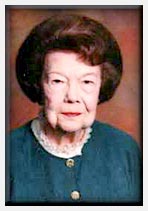J. C. Studer Built Pampa's First Meat Market |
|
 Eloise Lane
Eloise Lane
Julius Caesar Studer, born March 24, 1863 in Kastenholtz, Switzerland, was the son of Ben and Elsie Studer. When J. C. was three years old, his parents came to America and settled in a Swiss colony near Tracy City, Tennessee. At the age of ten, J. C. hired out as a farm hand, doing chores for Mrs. F. Banks for $6.00 a month. At the age of thirteen, he apprenticed himself to a carriage maker in Grundy County, Tennessee, and, after six years, he was earning $35.00 a month. Soon after his nineteenth birthday, he invested his savings in a new suit and a railroad ticket for Kiowa, Kansas. With the help of a cowboy friend from the Bar T Ranch in Lipscomb County, J. C. filed on a 640 claim, 10 miles from the present town of Lipscomb, Texas in 1886. On the return trip to Kiowa after filing his claim, his horse died and he walked the remainder of the 150 miles to reach Kiowa. J. C., who did not like "close quarters," decided that Kiowa was getting too big and that too many people were settling too close to his Lipscomb County claim; so he came to Canadian in 1887 when the population was boasted to be 50 people and the grass was "belly deep to a horse." His first work in Canadian was buffalo hunting, gunsmithing and making bridle bits and spurs, and he soon opened a livery stable and feed store. He wanted to learn all about cattle and how to work them, so before going into his own cattle business, he worked for several ranches, including the P.O. Bar CC, Turkey Track and the Ed George spread, later on the Washita. He bought a part of the P. O. Ranch and established his Anvil Park Ranch, using the anvil for his brand. A man bet him that he could not make that kind of brand, but he did. He had learned the blacksmith trade in his early labor jobs and had worked as a machinist for Courtney Railroad Contractors. For many years J. C. was blacksmith for the Santa Fe Railroad. J. C. Studer's 5,000 acre spread became the location for the annual 4th of July ANVIL PARK RODEO, famous throughout the Southwest from 1918 to 1941. It had its beginning in the summer of 1888 when the first rodeo in Texas (and perhaps in the world) was held at Canadian. The original 1888 celebration was the outgrowth of cowboys' contesting at the Santa Fe stockyards. It was a common sight for cowhands to try their luck on the unbroken horses handled there while interested spectators gathered along the fences. A group of cowboys from the Laurel Leaf Ranch originated the idea of holding a public contest and celebration. Space was provided on grounds adjacent to the stockyards for the two-day events, but the dirt streets of the town were used for horse races, tournament races and all the long-distance contests. People came from all the outlying districts in creaking buckboards, dusty buggies and on horseback to join in the festivities, camping at night along the river. The ANVIL PARK RODEO was a non-profit incorporated association directed by the business, professional and ranching men of the area. The best of rodeo cowboys traveled to Canadian to demonstrate their skill and ability in the three-day series of events. The ANVIL PARK RODEO had the distinction of being the first rodeo and old timers' reunion to be staged as a community undertaking anywhere in the Southwest. It was open to the public who traveled on specially scheduled Santa Fe trains from as far away as New York to see authentic cowboy sports on an authen- tic Texas ranch. On June 28, 1890, J. C. married Ella Gallaher, sister of Will Gallaher, a Fort Worth rancher. J. C. and Ella were the parents of six sons and one daughter. A picture in "Cowmen and Ladies” (A History of Hemphill County, p. 275) shows J. C. and Ella; sons Floyd, Carl, Oscar, John, Otto, and daughter Lola. Mrs. Ella Studer died on June-l7, 1932. J. C. was the pioneer in manufacturing ice in the Panhandle of Texas. He also helped to inaugurate the first chain food stores in the area had grocery stores at Canadian, Miami, Perryton and Pampa. When asked why he had so many kinds of businesses, 3. C. answered, "I have so many different kinds of sons." J. C.'s first love was ranching, and that absorbed his interests until his eighty-ninth birthday. AS a Hereford breeder, he was one of the founders and charter members of the Panhandle and Southwest Livestock Association which later merged with the Texas Cattle Raisers Association. In 1950 J. C. sold 5,000 acres of the Anvil Park Ranch to the Texas Game and Fish Commission for a wildlife refuge. Teeming with deer, turkey, and seasonal migratory birds, the Gene Howe Wildlife Management Area became a mecca for nature lovers. After celebrating his ninetieth birthday, J. C. built a new post office on the lots where his market and bakery were located for many years. He drove his car to town every day to supervise construction. He was active in community and church work and in the management of his ranch until a few months before his death on May 6, 1957.

